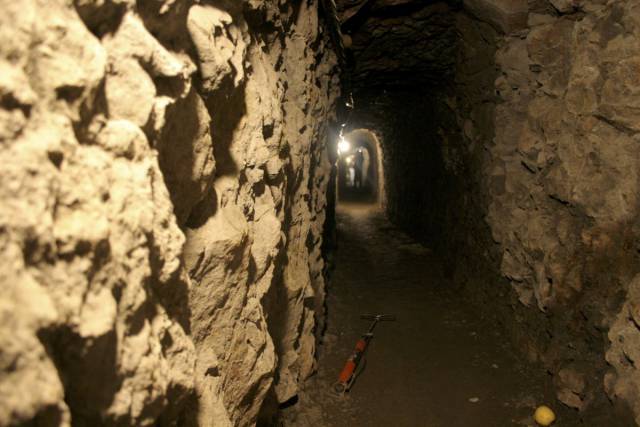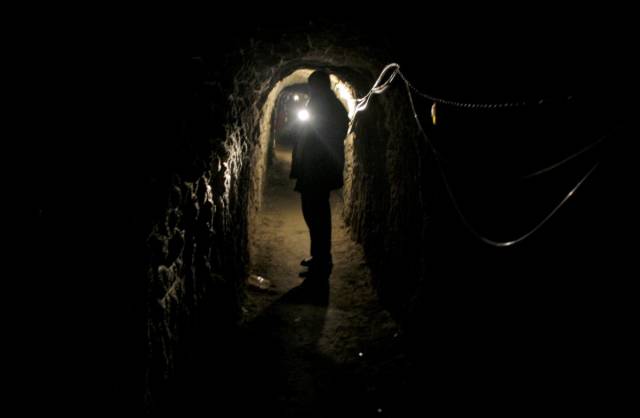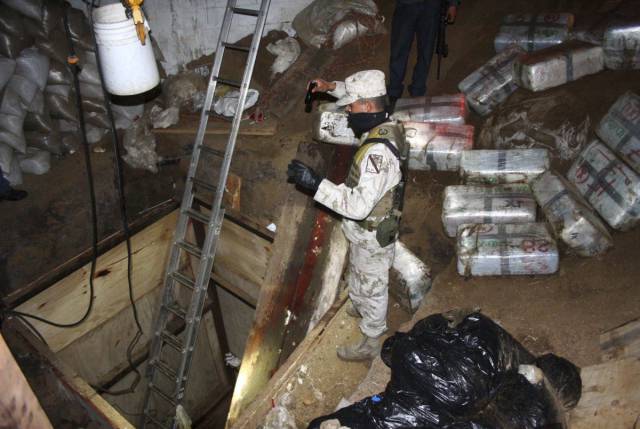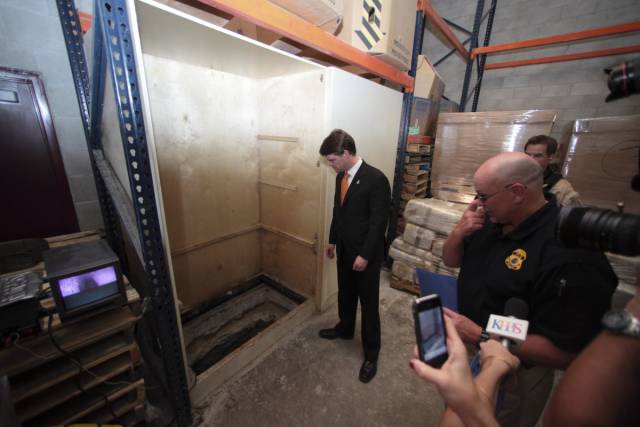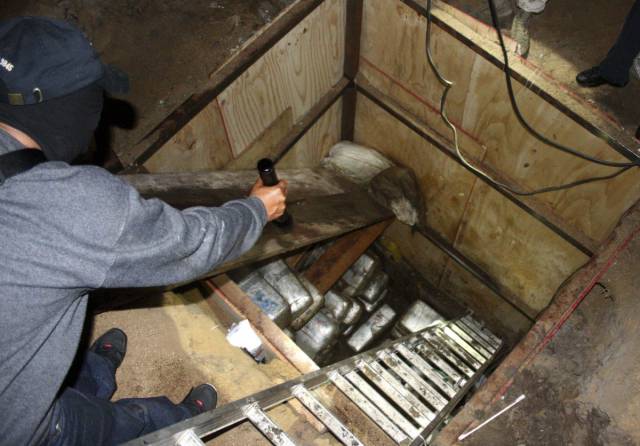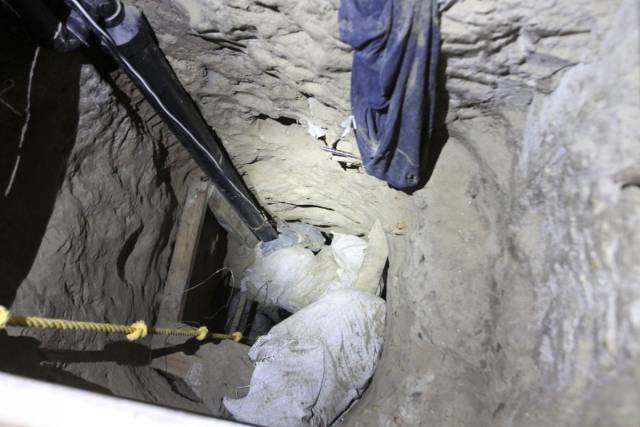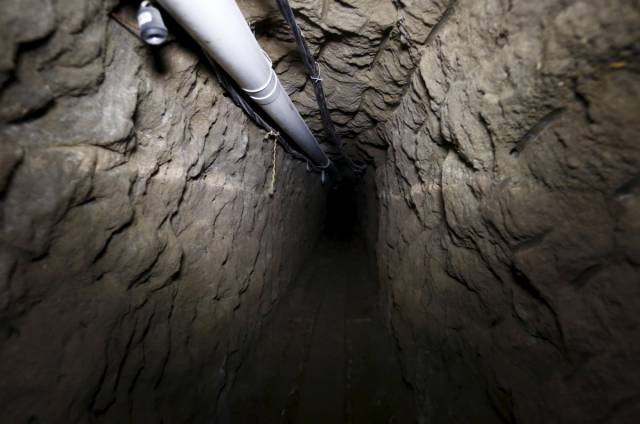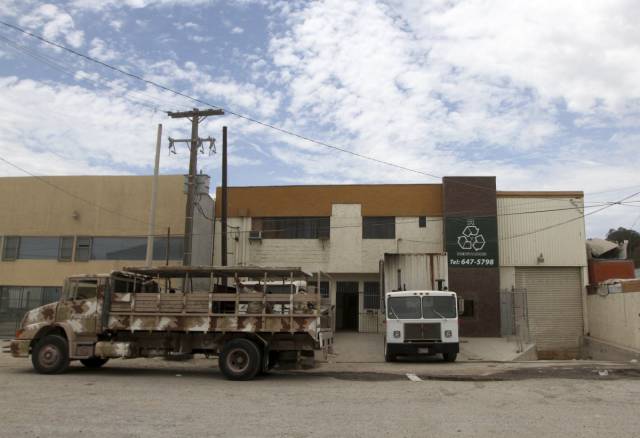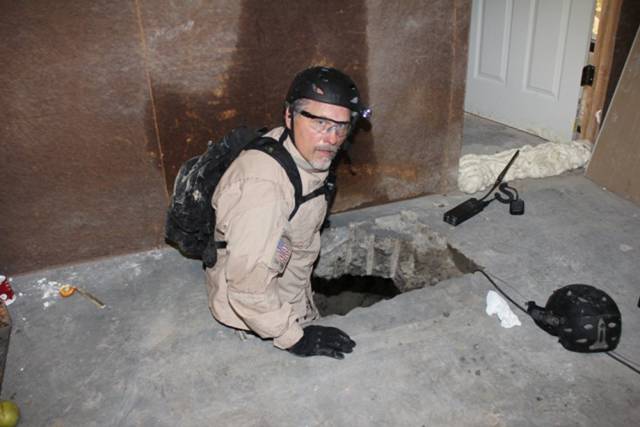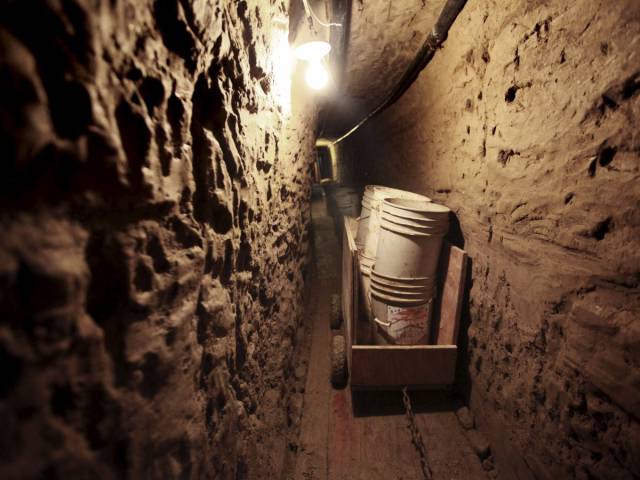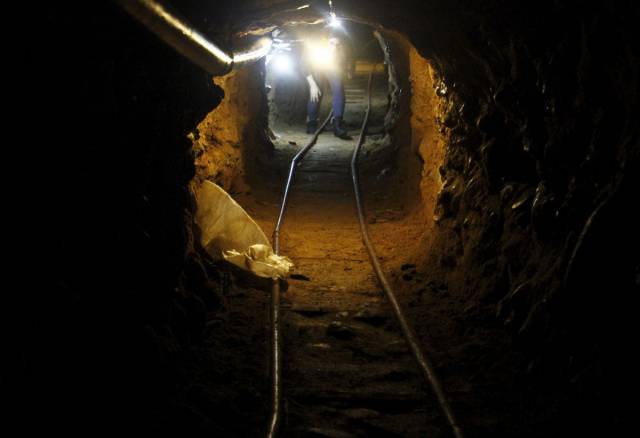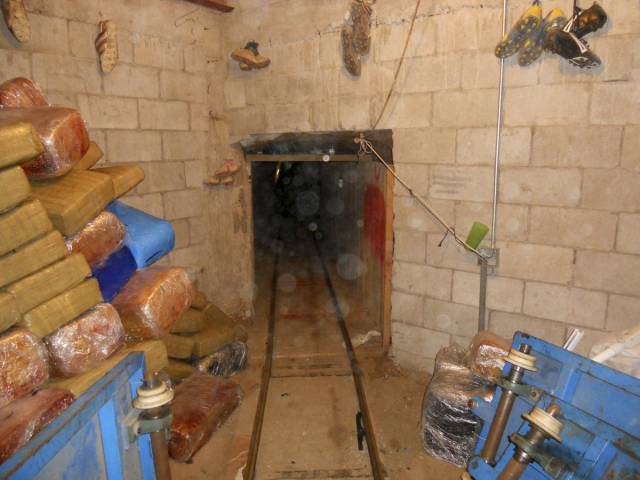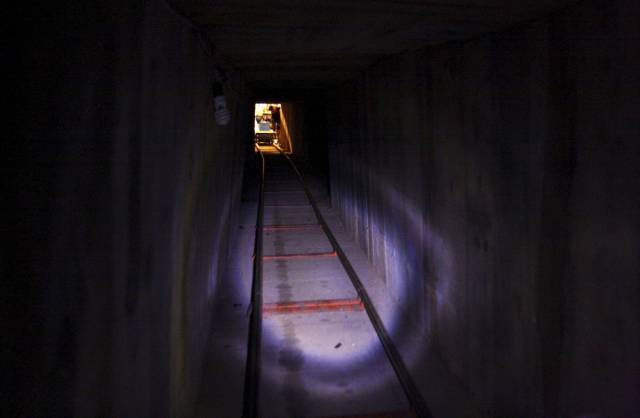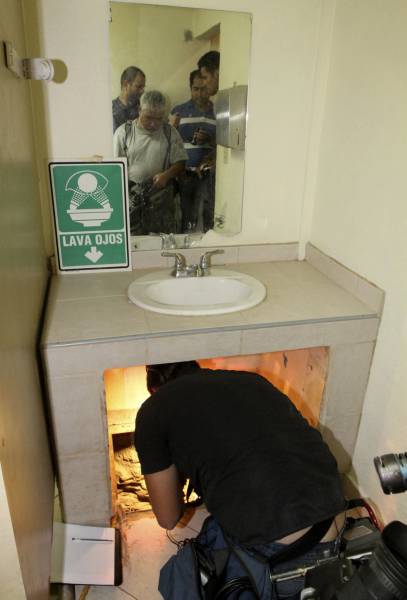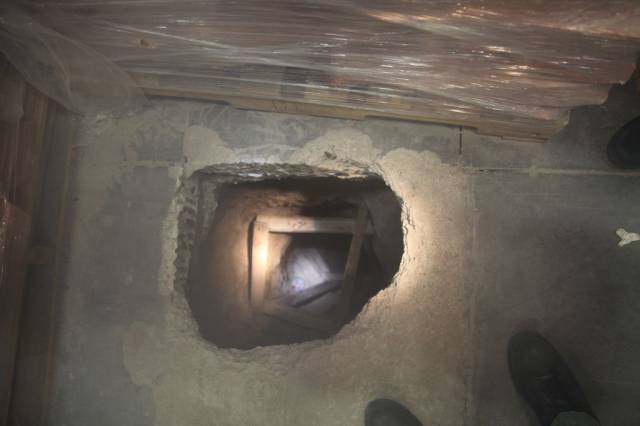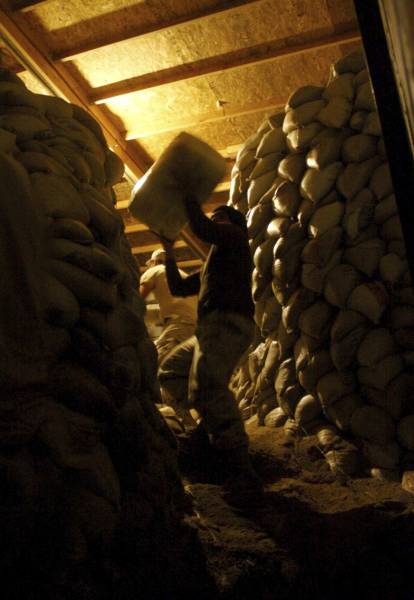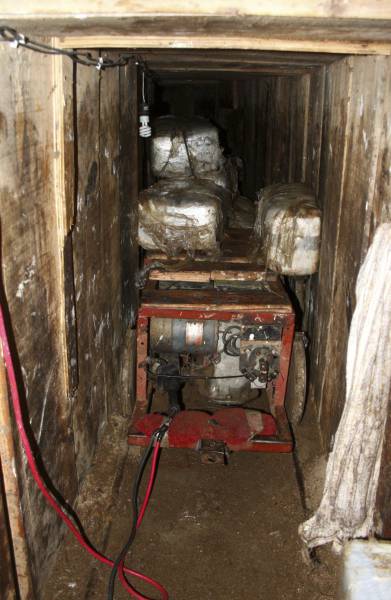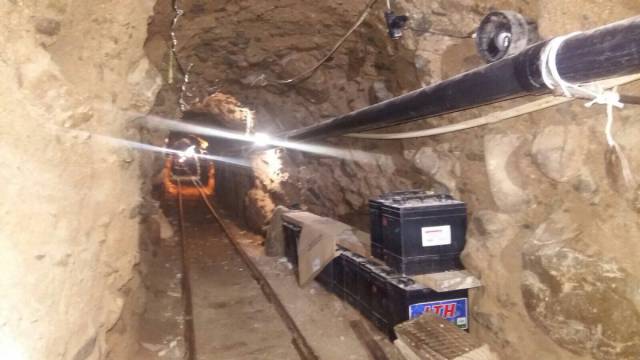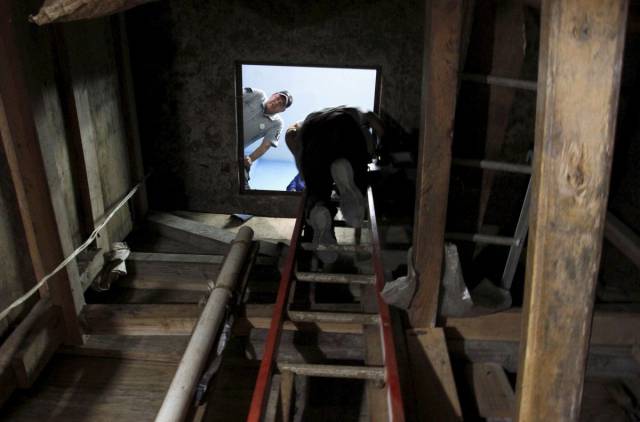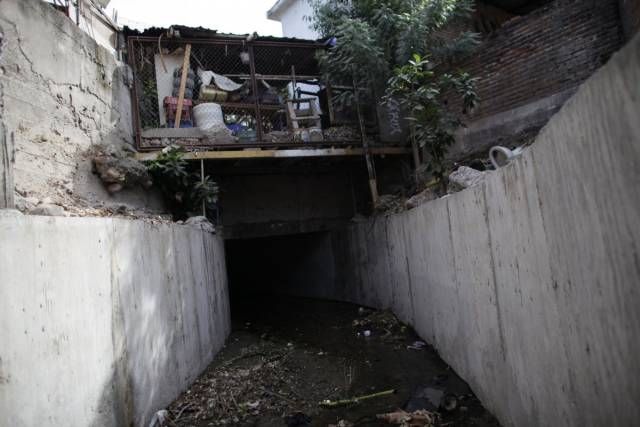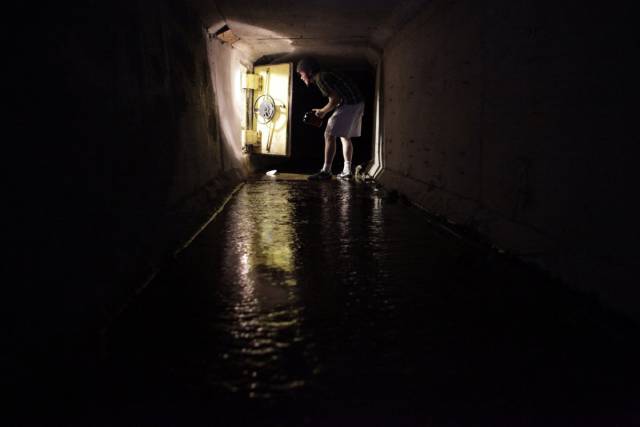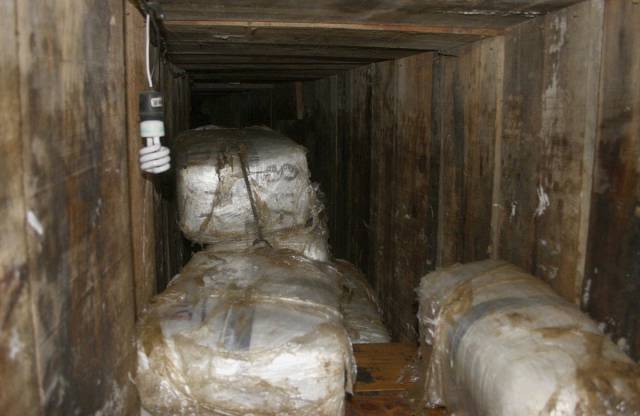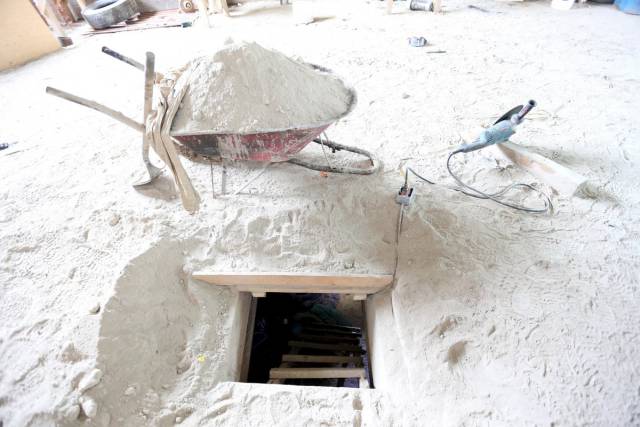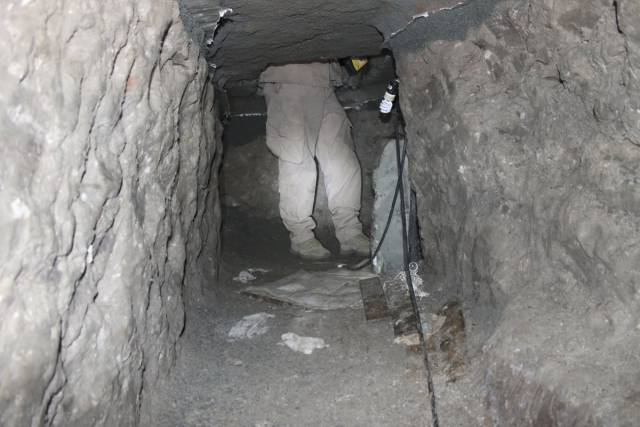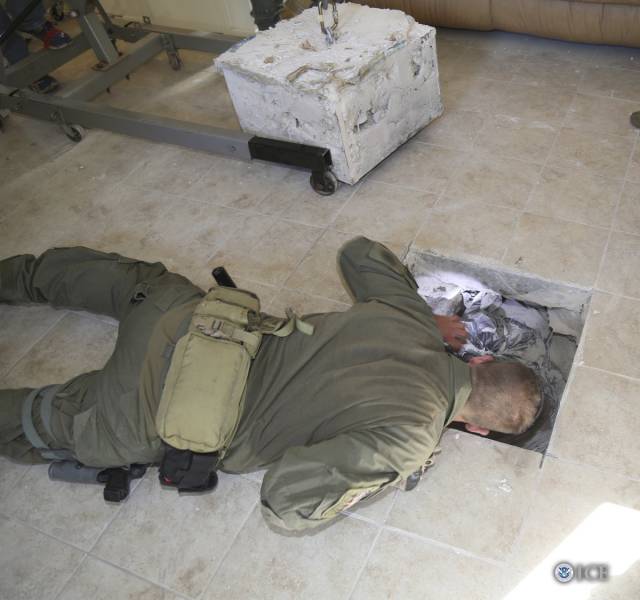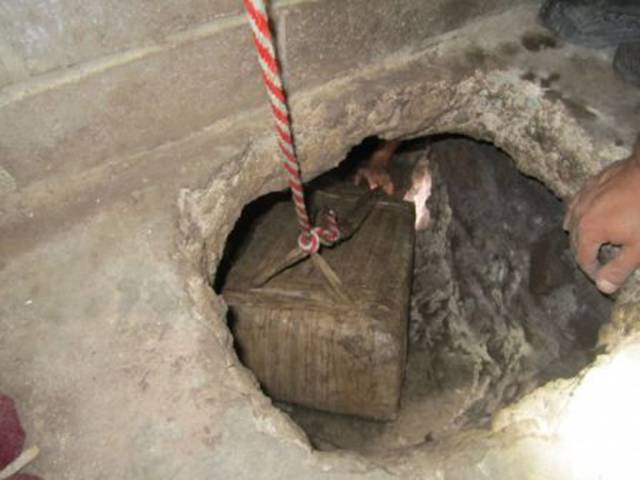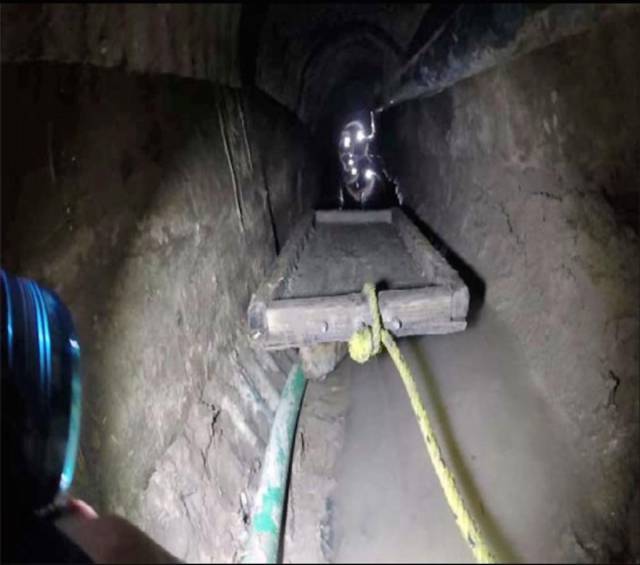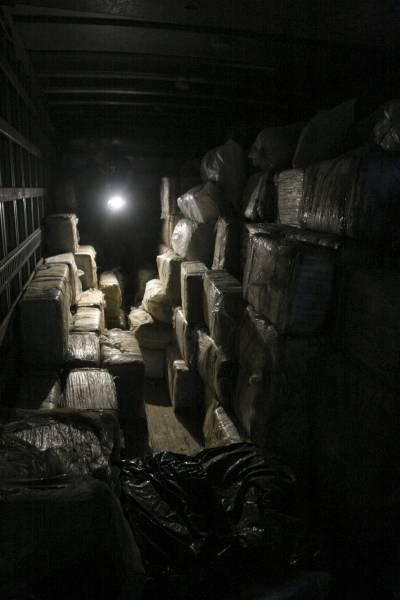There are tunnels all along the 2,000-mile frontier between the US and Mexico that were dug by drug traffickers. They are also used for illegal immigration. Journalist Ioan Grillo said “The Mexico-US border is like a block of cheese with holes in it, with tunnels across it.”
“Many, many years ago, they were very unsophisticated. They weren't very long. They were relatively short,” Vigil said. The first so-called narco tunnel was built in 1989, by the Sinaloa cartel of Joaquín "El Chapo" Guzmán.
A tool is seen in a tunnel under the US-Mexico border that started in Tecate and ran into Southern California, December 4, 2007. Gunmen killed the police chief of Tecate, a Mexican city bordering California, by shooting him some 50 times in an apparent revenge attack after police found the drug-smuggling tunnel under the border.
"You look at some tunnels which are very, very basic, and I've been to look at some of these from the US side," Grillo said. "And you see that they're quite basic, you know, shovel, get in there, and kind of dig through under the border quite basically."
A man stands in a tunnel under the US-Mexico border that started in Tecate and ran into Southern California, December 4, 2007.
Over the past 25 years, authorities have found 181 narco tunnels under the US-Mexican border, according to The New Yorker. Most of those have been short, narrow passages, or "gopher holes."
Tools are seen in a tunnel under the US-Mexico border that ran from Tecate, Mexico into Southern California, December 4, 2007, after it was discovered by law-enforcement agencies.
Narco tunnels have proliferated along the US-Mexico border, but it was the Sinaloa cartel that pioneered this method of subterranean smuggling, first in its area of influence along the Arizona border, expanding all along the frontier as the cartel grew in power.
A Mexican soldier stands next to the entrance of a tunnel and packs of marijuana in Tijuana, November 3, 2010. US border police have found a sophisticated drug smugglers' tunnel the length of six football fields linking Southern California with Mexico and arrested two people, authorities said. Agents recovered more than 25 tonnes of marijuana in seizures related to the investigation in both California and Mexico and arrested a US citizen and his Mexican wife.
The Sinaloa cartel, under Guzmán's direction, "basically was the impetus for building tunnels across into the United States," Vigil said. "They started to then put in ventilation. They started to put in lighting, railroad carts to facilitate the movement of drugs and actually illegal aliens through those tunnels, and they became much longer, and they started to riddle the Mexican border with a massive amount of tunnels."
John Morton, left, director of the US Immigration and Customs Enforcement (ICE), stands inside a warehouse near the Mexican border where a long tunnel was found in Otay Mesa, California, November 3, 2010. US border police have found a sophisticated smuggler's tunnel the length of six football fields linking Southern California with Mexico and believed to have been used by drug traffickers, authorities said. Agents also recovered more than 20 tons of marijuana during overnight searches of the tunnel, the border patrol said in a news release.
The Sinaloa cartel's tunneling activity is heavily concentrated in the Tijuana area. Many of them have been found to stretch from Garita de Otay, an industrial area in the northern part of the city, to Otay Mesa, a neighborhood in San Diego that "consists of highways, strip malls, and a few hundred warehouses clustered near the border."
A Mexican soldier flashes his torchlight inside a tunnel in Tijuana, November 3, 2010. US border police have found a sophisticated drug smugglers' tunnel the length of six football fields linking Southern California with Mexico and arrested two people, authorities said.
Otay Mesa sits on a plateau that crosses the US-Mexico border. The ground there "is made of clay called bentonite that is self-supporting and as workable as wax."
A Homeland Security agent enters a tunnel used to smuggle drugs between the US and Mexico in this photo released on October 31, 2013, by the US Immigration and Customs Enforcement Department (ICE). The tunnel linked an industrial park in Otay Mesa, California, with Tijuana, Mexico, and featured both rail and ventilation systems.
Cartel laborers dig down into this layer of clay, which is sturdier than normal soil and reduces the need for bracing and other infrastructure to shore up the passageway, Vigil told Business Insider.
A view of the entrance to a tunnel under construction found by soldiers at a recycling plant at the Otay Mesa industrial park in Tijuana, July 12, 2012. The Mexican Army located the tunnel in this border, which would be used for smuggling drugs, weapons and persons into the United States, local media reported. The excavation, which is approximately 3 meters deep, 1.70 meters high, and 150 meters long, had ventilation and lighting. No detainees were reported
"In Otay Mesa, the soil is soft enough to be dug by hand, yet firm enough so that the tunnel walls can often stand without wood or concrete reinforcement," Reel reported for The New Yorker.
A tunnel connected to the Altiplano Federal Penitentiary and used by drug lord Joaquin "El Chapo" Guzman to escape is seen in Almoloya de Juarez, on the outskirts of Mexico City, July 15, 2015.
Industrial activity, as well as the flow of people and cargo between Tijuana and San Diego, provides excellent cover for illegal activity. "The bottom line is, you can probably shoot a bullet in the air and it’ll land on a warehouse that’s doing something illegal in this area," Tim Durst, then the supervisor of the San Diego Tunnel Task Force, told GQ in 2014.
A military truck is parked outside a recycling plant where soldiers found a tunnel under construction at the Otay Mesa industrial park in Tijuana, July 12, 2012. The Mexican army located the tunnel in this border, which would be used for smuggling drugs, weapons and persons into the US, local media reported.
The Sinaloa cartel developed its tunnel-building technique rapidly. Soon Guzmán's organization was constructing massive passages, hundreds of meters long, equipped with electricity, ventilation, and transport systems. "They've got skilled engineers making these, people who are qualified engineers, who will reinforce that tunnel, make it big, and have it so you bring actually rails on them, with trains, electric lights, air vents — very important, the air vents," Gillo told Business Insider.
An agent from the San Diego Tunnel Task Force lowers himself into the passageway of a tunnel found under the US-Mexico border in San Diego, November 26, 2010. US border agents said they had found a half-mile-long tunnel under the US-Mexico border and seized a significant amount of marijuana at the San Diego area warehouse where it ends.
One of the Sinaloa cartel's first tunneling gurus was Felipe de Jesus Corona-Verbera, who graduated from architecture school at the University of Guadalajara in 1980. Corona, who was close with Guzmán, was the driving force behind the cartel's first major tunnel, which connected Agua Prieta in Mexico with Douglas, Arizona.
A makeshift cart with containers is seen at a suspected drug tunnel under construction during a media tour by Mexican Army in Tijuana, April 7, 2015. Mexican soldiers foiled the construction of a suspected drug tunnel underneath a house near the US border, arresting nine people and impounding a truck used to clear debris, the army said. Wired with lights, the tunnel was being built next to the Tijuana border crossing, south of San Diego, California, and near a Mexican air force installation as well as a regional federal police facility.
The Agua Prieta-Douglas tunnel was a marvel, and it allowed the Sinaloa cartel to quickly expand its business — so quickly that the Colombians supplying them the cocaine started calling Guzmán "El Rapido."
A journalist walks through a tunnel discovered by the Mexican Army, during a presentation to the media in Tijuana, Mexico August 2, 2015.
The Sinaloa cartel later had another tunnel mastermind: Jose Sanchez-Villalobos.
Packages containing marijuana are seen next to a tunnel found under the Mexico-US border in Tijuana, November 29, 2011. Police discovered the tunnel running to California from Mexico and seized packages containing marijuana. The tunnel measured around 800 meters from the Mexican border city of Tijuana to Otay Mesa industrial park south of San Diego, according to authorities.
Villalobos was an adept manager who coordinated multiple tunnel projects while keeping a low profile. “Nothing I’ve ever seen criminally has worked as efficiently as it did when he was the boss,” an agent told The New Yorker.
A soldier looks into a tunnel found under the Mexico-US border in Tijuana, November 30, 2011. Police discovered the tunnel running to California from Mexico and authorities from both countries seized more than 32 tons of marijuana. The tunnel was equipped with a hydraulic entry, an elevator, and electric rail cars, according to a statement released by the US Immigration and Customs Enforcement.
Villalobos was arrested in early 2012 in Guadalajara. A Mexican court ordered his extradition to the US in late 2013, but he appealed. While his case made its way through the courts, Villalobos was held in the same high-security wing at Altiplano prison as his boss, Guzmán.
Members of the media wait for their turn to film the entrance to a tunnel under construction found by soldiers at a recycling plant at the Otay Mesa industrial park in Tijuana, July 12, 2012. The Mexican army located the tunnel in this border city, which would be used for smuggling drugs, weapons, and persons into the US, local media reported. The excavation, which is approximately 3 meters deep, 1.70 meters high, and 150 meters long, had ventilation and lighting. No detainees were reported.
The cartels often rely on forced labor to dig the tunnels. Poor Mexicans, frequently from the interior of the country, have been known to take work offers from cartel operators, only to find themselves locked in warehouses, working in shifts to dig north.
A view of the US entrance to a 400-yard cross-border tunnel after authorities recovered 14 tons of marijuana from warehouses in Otay Mesa industrial park and Tijuana, Mexico, in Otay Mesa, California, November 16, 2011. Police discovered the tunnel running to California from Mexico, and seized more than 17 tons of marijuana, US and Mexican authorities said.
"They're gonna grab these kids and are gonna hold them hostage until they finish the work," DEA Phoenix Special Agent in Charge Doug Coleman told an Arizona NBC affiliate in 2015. "Federal officials estimate it can take nine months or more to build the typical drug tunnel. 'Sometimes they (cartel leaders) pay them. Sometimes they don't. Sometimes when the job is over they will make them disappear,'" Colemen said.
A Mexican soldier removes packs of marijuana inside a tunnel in Tijuana, November 3, 2010.
Though the labor may be coerced, the engineering that goes into the tunnels is quite sophisticated. The Sinaloa cartel employs "tremendous mining engineers that know their business," Vigil said. "They understand the oxygen, and today they use this Total Station, which is a state-of-the-art instrument for constructing tunnels."
A generator and packs of marijuana are seen inside a tunnel in Tijuana, November 3, 2010.
Authorities have also come across equipment used by gas and drilling companies, including horizontal directional drilling machines, which are used to build pipelines.
A police officer guards packages of seized marijuana in this undated photograph provided by Mexico's Federal Police, October 22, 2015. Mexican police busted a smuggling tunnel run by the drug gang of kingpin Joaquin "El Chapo" Guzman on the US border stashed with about 10 tons of suspected marijuana, officials said. The tunnel, which ran under the border from the Mexican city of Tijuana, was some 2,625 feet long, the National Security Commission (CNS) said in a statement. Only about 650 feet of the tunnel were in the US.
"With some training, a single operator can drill a thousand-foot-long tunnel, burrowing at any angle, in a matter of weeks. The most advanced [horizontal directional drilling machines] monitor your progress in real time while a self-feeding system automatically lays pipe," Jason Kersten wrote for GQ in early 2014. "The biggest industrial rigs can drill holes five feet in diameter, wide enough for a human."
A police officer, left, looks on as a television cameraman climb into a tunnel discovered by Mexican army, during a presentation to the media in Tijuana, Mexico, August 2, 2015.
"Later, they figured it was easier to build tunnels into the drainage system that traversed the US-Mexico border, because it saves a lot of time and saved a lot money," Vigil told Business Insider. "So what they would do is build the tunnel, hit the drainage system, and then use that drainage system to come up on the US side."
A drain exit that leads to a tunnel underneath one of the houses of Joaquin "El Chapo"Guzman is seen in a neighborhood in Culiacan, in Sinaloa state, February 25, 2014. Guzman, who rose from humble origins to become one of the most powerful drug barons in history, was captured in a raid in the beachside resort and fishing center of Mazatlan, 125 miles southeast of Culiacan, just days after escaping from the clutches of Mexican troops through a tunnel and sewers in early 2014.
"When I was in San Diego, there were some people from Sinaloa — we know it was the Sinaloa cartel — that rented a house and what they did is they built a tunnel in the bedroom, they took out tiles, built a tunnel, probably about 15 feet down, and then started excavate, and they hit a drainage system," Vigil said. They "came out underneath the international wall there separating Tijuana and San Diego, and they went to the drainage system and there was a huge parking lot there, a public parking area where people would park their cars and then they could just literally walk across the border."
A Reuters journalist stands outside a steel door leading from the city's drainage system into a tunnel underneath one of the houses of Joaquin "Chapo" Guzman in Culiacan, Sinaloa state, February 25, 2014.
The tunnels have been used for a variety of contraband, but they are most suited to marijuana smuggling. Bulky and odorous, marijuana shipments are more troublesome to take through customs on the ground.
Packs of marijuana are stored in a tunnel in Tijuana, November 3, 2010. US border police found a sophisticated drug smugglers' tunnel the length of six football fields linking Southern California with Mexico and arrested two people, authorities said. Agents recovered more than 25 tonnes of marijuana in seizures related to the investigation in both California and Mexico and arrested a US citizen and his Mexican wife.
Despite the extensive effort that goes into constructing narco tunnels, and the huge loads that travel through them, they are often hard to detect. "US-Mexico border is literally riddled with tunnels, and the big problem is that there's no technology that can detect those tunnels," Vigil told Business Insider. For every tunnel found, about 10 go undetected, he said.
The entrance of a tunnel connected to the Altiplano Federal Penitentiary and used by drug lord Joaquin 'El Chapo' Guzman to escape, is seen in Almoloya de Juarez, on the outskirts of Mexico City, July 12, 2015.
The ground in the area around Otay Mesa has proven especially impenetrable for law-enforcement detection methods. "Most deep-set geophysical variations—seams of rock, mismatched strata of soil, and excavation projects—show up as indistinct lines," on the screens of the ground-penetrating radar machines that authorities use. To investigate each suspicious blip would cost too much.
A law-enforcement officer enters a drug tunnel found in a warehouse in Otay Mesa, California, April 3, 2014, in this handout photo released on April 4, 2014. US federal agents uncovered two drug-smuggling tunnels underneath the US-Mexico border, both surfacing in San Diego-area warehouses and equipped with rail systems for moving contraband, officials said. The discovery led to the arrest of a 73-year-old woman accused of running one of the warehouses connected to a drug-smuggling operation, according to a joint news release by four federal agencies.
Narco tunnels are hard to detect, extremely lucrative, and cartels have become adept at constructing them — all of which means that tunnel task forces on both sides of the border won't have a shortage of work anytime soon.
A US Homeland Security Investigations (HSI) Special Response Team agent looking into tunnel exit point during an investigation of a cross-border tunnel linking Calexico, California, and Mexicali, Mexico, in Calexico, California, March 23, 2016.
"I would say a normal tunnel will run anywhere from — depending on the length and complexity — anywhere from $1 to maybe $3 million," Vigil said. "And the fact of the matter is that once you run one or two loads that tunnel is paid for. You've paid for the tunnel. So is it worth it to them? Without question."
One of 26 bundles of marijuana, found inside a drug-smuggling tunnel from Mexico that was uncovered by the US Border Patrol in Nogales, Arizona, is shown in this photograph released on November 22, 2011. The tunnel was 319 feet long and extended 219 feet into the US and 100 feet into Mexico. It was approximately 20 feet below the surface and measures 3 feet wide by 2 feet tall. While securing the tunnel, Nogales Border Patrol agents found 26 bundles of marijuana weighing more than 430 pounds and worth approximately $215,000.
If cartel operators can use horizontal directional drilling rigs effectively, "not even the Rio Grande will be an obstacle. They’ll be able to dig tunnels within weeks, shrinking them to the size of plumbing pipes, and literally drill into the United States almost anywhere along the border they choose."
A dry section of a partially underwater tunnel used by smugglers who transported drugs from Mexicali, Mexico, north into California.
"The average lifespan [of a tunnel] could be a perpetual ... unless you have specific information from a human source, or there's unusual activity detected that would warrant a closer look, you're not going to fine those tunnels," Vigil told Business Insider. Tunnels are "a smuggling method that will probably continue and probably increase in the future, especially with the increased border patrols and the surveillance that is taking place along the border."
A reporter uses a torch to light marijuana packages inside a truck parked at a warehouse where the Mexican army located a cross-border tunnel in Tijuana, July 12, 2012. The army located a tunnel measuring 383 yards running to California from Mexico and seized some 50 tons of marijuana, local media reported. The tunnel was still under construction but had ventilation and lighting.

